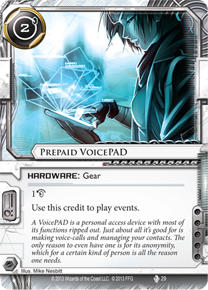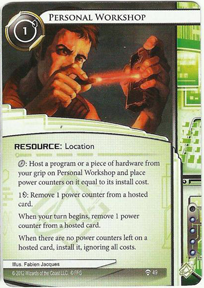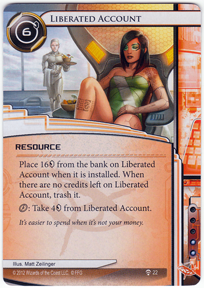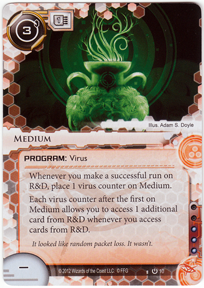Today’s article comes to us from the new StimHack author Ben Conn. Ben proposes a new way of talking and thinking about various runner economies.
Runner Economy and Deckbuilding
Compared to games like Magic, Android: Netrunner is fairly young. While other games give us a framework for understanding Netrunner in a more general sense, there are many aspects of A:NR for which we don’t have a clear analog in other games, and consequently we have been slow to develop a formal taxonomy for those aspects. Foremost among these are runner deck types.
We see players appropriating terms like “aggro” and “control” from other games, but in general runner archetypes are not as clearly defined as their corp counterparts (Rush, Glacier, Fast Advance, Flatline, etc.). While aggro and control broadly indicate the stage of the game in which a runner deck is strongest, runner decks are far less polar in that distinction than their counterparts in Magic. Any further comparison is limited in its efficacy, as it’s impossible to build a deck that goes off quickly so reliably as to completely disregard the long term as a true aggro deck does, nor does the concept of card advantage carry over from Magic closely enough for control to be an appropriate comparison.
I believe that as a community of players, we can develop the necessary theoretical understanding of the game to begin talking about runner decks with clarity and precision. As a starting point, I’d like to propose a taxonomy of runner economy, and then expand to the other aspects of deck construction which flow from that dichotomy.
Two Types of Economy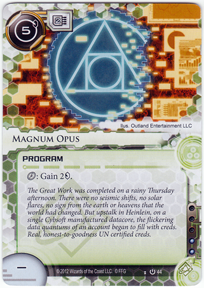
For runner decks, there are two types of economy available: steady economy and burst economy. The former category is best exemplified by cards like Desperado and Magnum Opus. Steady economy helps you win the game by means of click compression, ensuring that the runner has to click for credits less frequently.
The latter category can be seen in cards like Stimhack and Katie Jones. Burst economy creates a sudden swing in credits, allowing the runner to create an opening where none appeared to be, or to continuously threaten to do so. The runner is pulling back the money slingshot to eventually fire with precision when the time is right.
While the distinction between these two types of economy is not news, understanding these two types of economy lays the groundwork for distinguishing between the two distinct types of runner decks. The economy of a deck dictates the way in which it can apply pressure to the corp, and that method of applying pressure is the defining characteristic of a runner deck archetype.
Throwing Punches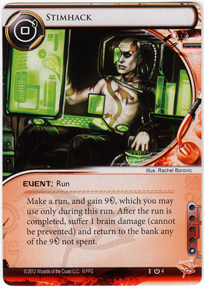
Decks with steady economy are able to run sustainably. They may not always be sitting on huge piles of cash, but they can usually run every turn without exhausting their resources. This lends itself to pressuring the corp through constant running. To use a boxing metaphor, the runner is throwing a flurry of punches, forcing the corp to reveal an opening.
Decks with burst economy can run more explosively. Rather than hitting the corp every turn, they develop their board position such that they can slam head-first into a super-server and make it out alive with an agenda, or make a devastating event run that the corp isn’t prepared for. Continuing our metaphor, these runners throw haymakers. When they swing, they’re looking for a knockout, a big turn that puts them significantly ahead.
Implications for Deck Construction
To better understand this dichotomy between runner deck types, we’ll look at each component of a runner deck, and how they differ. I will occasionally use examples from top-tier runner decks, primarily Fixed-Breaker Andromeda and Prepaid VoicePAD Kate, but note that individual instances of these decks can vary, and different iterations may exist at different places on the spectrum.
Economy
Perhaps the obvious starting point, the economy of these two runner decks shows a dramatic difference in approach. Flurry decks like Andromeda emphasize generating maximum value by running. Andy decks use Desperado as their console, along with Datasuckers, John Massanori, and Security Testing to ensure that they can run continuously, and fold their resource-generating clicks into their runs. While it is possible for these decks to accumulate large sums of money, especially after an Account Siphon, their strength lies more in their ability to keep running when their pockets are close to empty.
Haymaker decks are more likely to double down on event economy, with cards like Lucky Find providing startling bursts of cash. These decks going to be running less frequently, and may spend several clicks prepping as they install their Prepaid VoicePADs, double-click with Lucky Find, and pull back the Kati Jones slingshot. But when these decks are ready to run, the corp is unlikely to be able to stop them. If one were to graph credit totals for either of these decks, flurry decks would show straight-ish lines with gradual slopes, while Haymaker decks would be more like a Sine Wave. Stimhack is another premier burst economy card. It was most prominent in NoiseShop decks powering out huge mills, but also featured in Chaos Theory decks to rush out big programs.
Arbitrage
Not all runner decks will have access to economy only in their chosen form. To make the best of the economy cards available to them, some runners may have to convert one type of economy to another. Prepaid Kate is a prime example. The Prepaid VoicePADs allow Kate to use her ID text as burst economy. Normally a small, continuous discount is a steadier form of economy (see HB: Engineering the Future), but in this deck that discount lowers the threshold of profitability for VoicePADs, which in turn allow for larger and more sudden economic swings by lowering not just the cost but the barrier to use on cards like Lucky Find.
NoiseShop is another great example of a Haymaker deck converting steady economy into burst economy in its use of Personal Workshop with Stimhack. With in this deck, Workshop ceased to be a source of minor economic advantage over time, and became a powerful engine for spewing out viruses.
Non-Binary Options
Some cards can do work in either type of economy, but the way in which they are used varies based on that context. Dirty Laundry is a prime example. Flurry decks will run Dirty Laundry as a way of making an attainable run profitable, and as a means of click compression by taking on an extra payout to a run they would make anyway. Haymaker decks more use Dirty Laundry as yet another means of getting huge economic spikes out of Prepaid VoicePAD.
Armitage Codebusting is clearly a powerful steady economy card, as it is essentially a Magnum Opus with an expiration date and a low setup cost. However, the overall efficiency of the card means it can find a home in either archetype on power level alone. And, like Opus, haymaker decks can use Armitage as a quick way to kickstart their economy.
Sure Gamble is a similar case in the opposite direction. It is burst economy, but it provides too many advantages for most flurry decks to overlook. It is especially valuable in an opening hand, as it can offset setup costs and get you running faster.
At first glance, Liberated Accounts would seem comparable to Armitage, but its high setup cost for limited durability are prohibitive in flurry decks. The slightly larger swing it can create in a shorter amount of time makes it better suited for Haymaker decks despite its resemblance to Armitage. (In either case, better options are generally available to either archetype.)
Breakers
Depending on your deck’s choice of economy, different breakers will be better suited than others. But the choice of breakers isn’t just about what you can afford, it’s about selecting a suite that is consistent with your gameplan. The combination of economy and breakers should send a clear, unified message about how your deck wants to make runs.
The Anarch fixed breaker suite offers everything a flurry runner could ask for. The low install cost of these breakers means the runner can start running as quickly as possible, and their efficiency, especially Yog.0’s free breaking, means that runs remain sustainable or even profitable. Running through Enigma for free means that Security Testing can continue to act as a repeatable Easy Mark even after the corp starts rezzing ice, and these breakers offer natural synergy with Datasuckers which also reward constant running. In short, this breakers suite allows flurry runners to threaten as many servers as possible as sustainably as possible.
By contrast, haymaker decks are more interested in punching a hole exactly where they want to go. This means Self-Modifying Code, Personal Workshop, and Clone Chips to get exactly the desired breaker mid-run, Parasites to permanently remove obstacles, and Atman to nullify specific ice. Many of these decks also run Datasucker, which makes Atman more flexible, but also allows for much more immediate, targeted Parasite use. These decks aren’t afraid to throw money at the problem, so long as they throw it in a precise and targeted manner.
That approach doesn’t mean that efficiency concerns go out the window. Haymaker decks do want to get their money’s worth. Though big breakers ask too large of a setup cost of flurry decks to be effective there, they are a strong choice for haymaker decks like Dinomite. This Chaos Theory deck uses Test Run/Scavenge and Modded to deploy these breakers in a fast, targeted manner to gain efficient, unstoppable access for huge event runs. These decks are less concerned with building a rig that can usually get them in wherever, and more interested in building one that can guarantee to get them in where and when it counts.
Though their overall viability is questionable, the central-only breakers are another example of cards clearly designed for flurry decks. The Silhouette deck that won Chicago Regionals is a prime example of this philosophy in action, as it takes advantage of the steady economy’s click compression to run all three centrals in a turn. In this deck, Magnum Opus is the economic engine, as the console slot is needed for Doppelganger.
R&D Tech
Consistent with these running strategies, these archetypes also differ in their approach to multi-accessing R&D. Flurry decks tend to prefer R&D interface, as they can hit R&D consistently and sustainably enough to achieve a lock. Andromeda uses R&DI for late game inevitability, as does Magical Kate (the Kate build with Desperado and Magnum Opus). Haymaker strategies prefer event-based R&D tech, with Indexing being my event of choice. Drop an Indexing when you’re ready to swing in for a big hit, and the odds are strongly in favor of scoring. Because your breakers are targeted, it’s unlikely that R&D will be so expensive to run that you can’t come back to grab those agendas you placed on top.
Medium does throw a curveball at this style of evaluation. Because it grows with every access, and requires successful access (or Grimoire) before it even starts to do anything, one would think it belongs in a flurry deck. After all, you need a steady economy to run efficiently enough to build a threatening number of counters. However, the ability to make a huge multi-access run, and the synergy potential with Demolition Run mean that Medium has a lot to offer to haymaker strategies. Surge offers a first nudge towards this kind of use, and the recently spoiled Incubator suggests that Medium as a haymaker tool will become stronger in the near future. In some ways, Medium embodies many of the problems Anarch faces as a faction at present, as it can be difficult to create an Anarch deck with an economy consistent with its gameplan.
Conclusion
I hope that this dichotomy of runner decks can help give a language to many of our thoughts about the game. Since developing this terminology, I’ve found that I can more easily put the many decks I see in context. I’ve been able to look at decks that are successful and learn to play them more quickly, and I’ve been able to look at decks that aren’t quite there and see the tension between their economy and the rest of their gameplan.
I recently advised a friend who was building a Ken deck on this topic, as his overall strategy suggested a flurry of runs, but his breaker suite required setup costs that his economy couldn’t support. To further compress clicks and run constantly he used Doppleganger as his console, but unlike the Silhouette Notoriety deck, he did not have economy cards to fill the Desperado-shaped hole in his deck. With this framework in mind, we were able to sort his deck between the components that supported his plan and those that did not, and I think we made considerable improvements.
I hope this article will help you apply this lens to your own play and deckbuilding. I look forward to seeing the Netrunner community continue to develop its own theory, language, and analytical tools.





